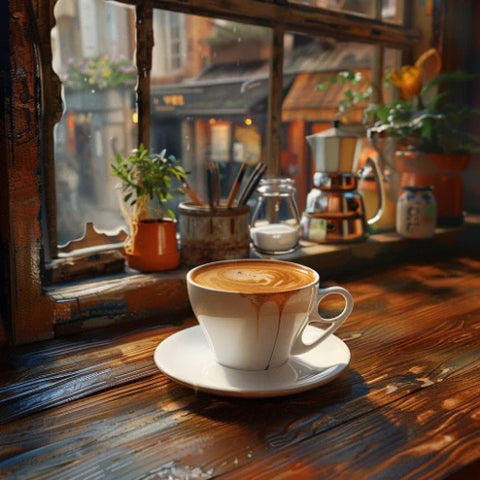Percolated coffee is a popular brewing method that involves passing boiling water through ground coffee beans to extract the flavor and aroma. It has been a traditional method of coffee brewing for many years and is still favored by many coffee lovers today.
One of the most common questions about percolated coffee is how long it should be brewed for the perfect cup. According to coffee expert and author, Scott Rao, the ideal time for percolation is between 5-7 minutes. However, there are various factors that can affect the percolation time, such as the type of coffee, grind size, water temperature, and the percolator itself.
To percolate coffee, follow these simple steps:
- Step 1: Prepare your equipment by cleaning the percolator and making sure all parts are assembled properly.
- Step 2: Measure your coffee and water, using a ratio of 1 tablespoon of coffee per 4 ounces of water.
- Step 3: Heat the water in a separate pot or kettle until it reaches boiling point.
- Step 4: Add the ground coffee to the percolator and assemble the lid.
- Step 5: Place the percolator on a heat source and start percolating. Keep an eye on the percolator to ensure it doesn't boil over.
- Step 6: Monitor the percolation process and adjust the heat if needed to maintain a slow and steady percolation.
- Step 7: Once the coffee has percolated for 5-7 minutes, remove it from the heat and let it rest for a minute or two before serving.
If you want to adjust the percolation time, you can make the coffee stronger or weaker by changing the amount of coffee and water used. For a stronger cup, increase the amount of coffee or decrease the amount of water, and for a weaker cup, decrease the amount of coffee or increase the amount of water. With these tips, you can enjoy a perfectly brewed cup of percolated coffee in no time.
What Is Percolated Coffee?
Percolated coffee is a brewing method where boiling water is circulated through coffee grounds using gravity or pressure. This process allows the water to absorb the coffee's flavor and aroma, resulting in a robust and aromatic brew.
How Does Percolated Coffee Taste?
- Rich flavor: Percolated coffee is known for its robust and full-bodied taste, making it a popular choice for those who prefer a stronger flavor profile.
- Aroma: The percolation process enhances the natural aroma of the coffee, filling the air with a delightful and inviting scent.
- Bitterness: Depending on the brewing time, percolated coffee can sometimes have a slightly bitter taste due to over-extraction. It's important to monitor the brewing time for the desired level of bitterness.
- Customization: With the ability to adjust the percolation time and the coarseness of the coffee grounds, individuals can customize the taste to their liking, making it suitable for a variety of palates.
Read: Moka Pots VS Percolators: Which Is A Better Buy?
What Is the Perfect Timing for Percolating Coffee?
The ideal timing for percolating coffee varies depending on personal preference, but generally falls between 7 to 10 minutes. This duration allows the water to effectively extract the flavors and oils from the coffee grounds, resulting in a rich and robust brew. However, it is important to closely monitor the percolation process to avoid over-extraction, which can result in a bitter taste. Experimenting with different timings can help you find the perfect balance for your taste buds.
Fun Fact: Did you know that the percolator, an early method of brewing coffee, was patented in 1865 by James Nason? It remained a popular brewing method until the mid-20th century when the drip coffee maker gained prominence.
What Factors Affect Percolation Time?
Several factors influence the time it takes for coffee to percolate. The size of the ground coffee beans plays a significant role in determining the percolation time. Finely ground coffee allows water to pass through faster than coarsely ground coffee, resulting in a shorter percolation time. Additionally, the temperature also affects the percolation time, with higher temperatures speeding up the process and lower temperatures prolonging it. The quantity of coffee and water used also plays a role in the percolation time, with larger amounts extending the time and smaller amounts shortening it. Understanding these factors is crucial in achieving the perfect percolated coffee, as it allows for control over the percolation time to match personal taste preferences.
How to Percolate Coffee?

Brewing the perfect cup of coffee requires precision and patience. One method that has stood the test of time is percolating. But how exactly do you percolate coffee? In this section, we will break down the process step by step, from preparing your equipment to the final product. With a little practice and attention to detail, you'll be enjoying a perfectly percolated cup of coffee in no time. So let's jump in and learn how to percolate coffee like a pro!
Step 1: Prepare Your Equipment
- Clean the percolator thoroughly, making sure to remove any previous coffee residue.
- Inspect all components for any damage or issues that could affect the percolation process.
- Assemble the percolator according to the manufacturer's instructions, ensuring a secure fit for optimal percolation.
- Check the power source if using an electric percolator, ensuring it is in good working condition.
- For stovetop percolators, make sure the heat source is ready and suitable for the percolation process.
Step 2: Measure Your Coffee and Water
When preparing your percolation coffee, it's important to measure your coffee and water accurately. Here are the steps to follow for a perfect brew:
- Start by measuring your water: Use a 1:15 coffee-to-water ratio for a strong brew or a 1:17 ratio for a lighter taste.
- Measure your coffee: For a standard strength, use 1 to 2 tablespoons of ground coffee per 6 ounces of water. Adjust based on your preference.
Read: How To Measure Coffee Without A Scale For Better Coffee
Step 3: Heat the Water
- Fill the percolator's water chamber with the desired amount of water.
- Place the percolator on a heat source, such as a stove or campfire.
- Step 3: Heat the water until it reaches the ideal temperature for coffee brewing, typically around 195°F to 205°F (90°C to 96°C).
True story: One chilly morning while camping, I carefully heated the water in the percolator over the crackling campfire. As the sun rose, the aroma of freshly percolated coffee filled the air, creating a warm and comforting start to the day.
Step 4: Add Coffee to the Percolator
- Open the percolator and remove the top and the basket from inside.
- Measure the appropriate amount of coffee grounds based on your preference and the percolator's size.
- Add the measured coffee grounds to the basket, ensuring an even distribution.
- Place the basket back into the percolator and ensure it is securely in place.
- Close the percolator tightly to avoid any spillage during the percolation process.
Did you know? The percolator method of brewing coffee was popular in the 1970s before the rise of drip coffee makers.
Step 5: Assemble the Percolator and Start Percolating
- Assemble the percolator: Ensure all components of the percolator are clean and in good condition.
- Add water and coffee: Fill the percolator with the desired amount of water and add the appropriate quantity of coffee grounds to the basket.
- Secure the percolator: Properly attach the top section of the percolator to the bottom, ensuring a tight seal to prevent steam from escaping.
- Start percolating: Place the percolator on the heat source, and wait for the water to boil. Once boiling, the water will bubble up through the coffee grounds and into the upper chamber.
- Monitor the percolation process: Keep an eye on the percolation process to ensure the coffee is brewing at the desired strength.
Step 6: Monitor the Percolation Process
When monitoring the percolation process while making coffee, follow these essential steps:
- Check the percolator's glass knob to observe the color of the coffee as it percolates. Adjust the heat to control the percolation speed.
- Observe the coffee's aroma and color through the glass knob. When it reaches the desired strength and color, carefully remove the percolator from the heat source to prevent over-extraction.
- For a richer flavor, allow the coffee to percolate for a longer time, but avoid exceeding eight minutes to prevent bitterness.
True story: During a camping trip, my friend carefully monitored the coffee percolation process on a portable stove. With precise observation and a keen sense of timing, he successfully brewed the perfect pot of coffee, earning praise from everyone around the campfire.
Step 7: Remove from Heat and Let It Rest
- Once the percolation process is complete, carefully remove the percolator from the heat source to avoid over-extraction and a bitter taste.
- Allow the coffee to rest for a few moments, which is an essential step in the percolation process. This helps in the settling of the grounds and allows the flavors to meld for a more balanced taste.
- After letting it rest, you can then proceed to serve the freshly percolated coffee and enjoy its rich and aromatic flavor.
Fact: Allowing the coffee to rest after percolation enhances the overall taste and aroma, resulting in a more satisfying coffee experience.
How to Adjust Percolation Time?

- Grind size: Adjust the coarseness for a longer percolation time, and a finer grind for a shorter time.
- Heat level: Increase the heat for a shorter percolation time, and decrease it for a longer time.
- Coffee amount: Use more coffee grounds for a longer percolation time, and less for a shorter time.
- Water amount: Increase the water for a longer percolation time, and decrease it for a shorter time.
- Experiment with these factors to achieve the desired brew strength and flavor by adjusting the percolation time.
How to Make Percolated Coffee Stronger?
- Choose a darker roast: To make percolated coffee stronger, opt for a darker roast that will intensify the flavor and strength of the brew.
- Use more coffee: Increase the ratio of coffee grounds to water. While the standard recommendation is 1 tablespoon of coffee per 6 ounces of water, using 1.5 to 2 tablespoons per 6 ounces will result in a stronger brew.
- Extend percolation time: For a stronger brew, allow the coffee to percolate for a longer duration. This will extract more flavor and caffeine from the coffee grounds.
- Experiment with grind size: Achieve a stronger flavor by using a finer coffee grind, which exposes more surface area of the coffee grounds to the water during percolation.
How to Make Percolated Coffee Weaker?
- To achieve a weaker percolated coffee, start by adjusting the coffee to water ratio. Use a larger quantity of water compared to coffee grounds, such as a 1:15 ratio, to dilute the strength.
- Grind the coffee beans coarser to reduce extraction and create a milder flavor during percolation.
- Shorten the percolation time by keeping an eye on the brewing process and removing the coffee from heat sooner to prevent over-extraction.
- Consider using a lighter roast coffee, as darker roasts can yield a stronger, more intense flavor.
- Experiment with different coffee bean origins, like Brazilian or Colombian, known for their mellow and less intense taste, to achieve a weaker percolated coffee.


